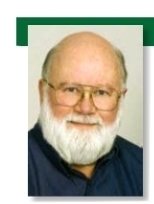 |
 |
| |
www.K2TQN.com/
Monthly Support page for the Vintage Radio column in QST® magazine. Most months I provide additional information about the profiled radio or content of the column.
|
February 2014
John Reinartz, K6BJ, Testimonial Banquet
|
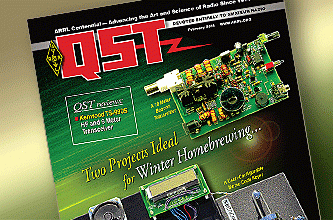 |
John L Reinartz, K6BJ, 1XAM, and 1QP
Very few men have done so much for ham radio. His entire life was about radio. He was a pioneer, an inventor, leader, and a patriot who served his country with honor. And at each turn in his life, ham radio was the beneficiary.
On February 1, 1960 more than 200 prominent radio amateurs attended his Testimonial Amateur Radio Banquet in San Mateo, California. As you read his biography from the banquet program, take your time. Read it again and pause after each paragraph and contemplate about the far reaching effects that came from each part of his life. |
|
| |
| |
| |
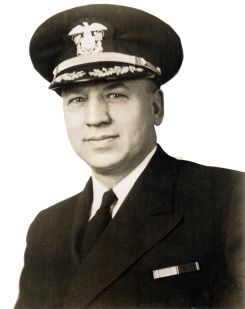
|
Click to read John Reinartz'
Testimonial Brochure

|
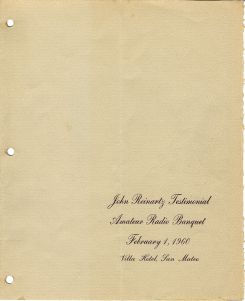
|
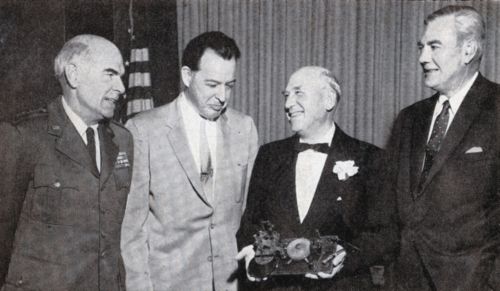
From left: Air Force Lt. General Francis "Butch" Griswold, K0DWC,
Bill Eitel, W6UF,
John Reinartz, K6BJ, (Holding his gag gift of a very early code practice device),
and Herbert Hoover, Jr., W6ZH. (CQ Photo, April 1960 page 50) |
| |
|
|
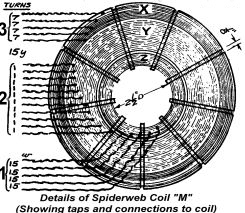 |
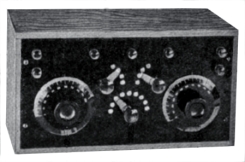
Reinartz Spiderweb coil, left, is shown below in the schematic. |
|
| By 1921, Reinartz developed the Reinartz tuner. It was given wide publicity, thousands were built, and it was the predecessor of most current receiving set tuners. In 1921, Reinartz was also publishing a magazine, distributed free, on "How to Build Receivers and Transmitters at Low Cost." His writings on the tuner and its improvements were published in "QST" in June, 1921, March, 1922 (shown left) and October, 1922. He published a new circuit for a transmitter (below-left) in June, 1923. In 1923, he was ARRL's assistant manager for Connecticut.
The Reinartz radio left, is from the March 1922 QST. Below is a nice Reinartz Tuner radio owned by Al Klase, N3FRQ, and may be seen at the New Jersey Antique Radio Club museum, located at the Inforage center. To visit: http://www.rtm.ar88.net/
For more detailed information on the Reinartz tuner check my March 2014 QST column and associated web page on this web site. |
|
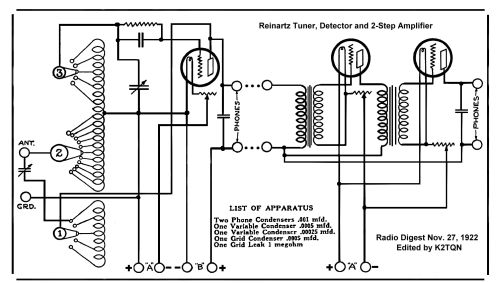 |
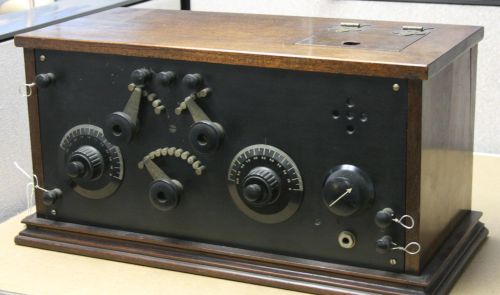 |
| |
|
|
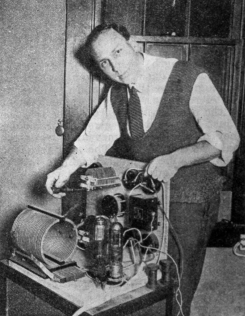
John Reinartz published a new circuit for a transmitter in June, 1923. In 1923, he was ARRL's assistant mgr for Conn.
His experiments, published in the April, 1925 issue of "QST," credited the "Heaviside" with bouncing back radio signals. This "Reflection Theory of Short Waves" explained the phenomenon whereby a low power transmitter could send shorter waves to its immediate area, and then, after passing a "dead space," could be received again at longer distances. |
|
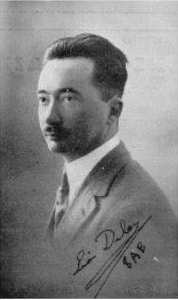
Leon Deloy, F8AB, Was the first to communicate with 1MO in the US, using circuits designed and given to him by John Reinartz earlier.
On November 27, 1923 five messages were received by Schnell and Reinartz, Schnell at 1MO in Hartford and Reinartz at 1XAM in South Manchester. Two messages were received by Deloy. The two-way messages were handled for a period of two hours. They worked on a wave length of 100 meters, from 9:30 to 10:30 on two successive nights. |
|
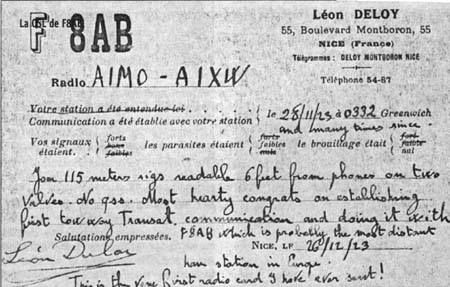
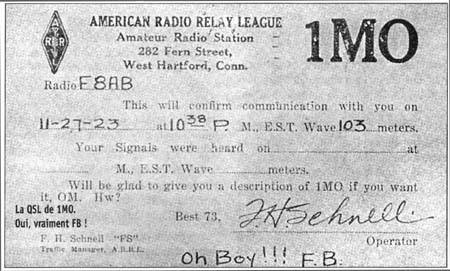
|
| |
|
|
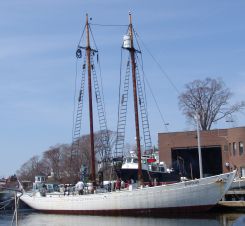
Schooner Bowdoin at the
Maine Maritime Academy.
She's still sailing.
|
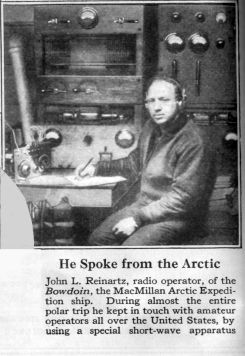 |
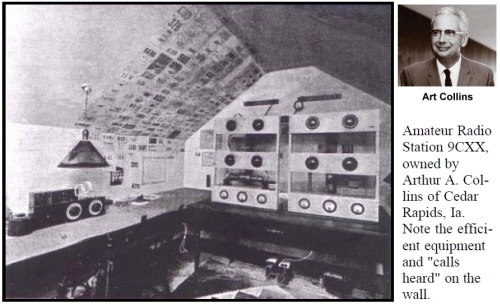
When John Reinartz was the radio operator onboard the Schooner Bowdoin with Richard Byrd in the Arctic in 1925, it was a young Art Collins (see Art's 1925 station in photo above) to which he contacted and passed many messages. Byrd was impressed and later selected Art Collins to build his radios for the Antarctic expeditions. Thus Collins radio got a big start. Collins radio went on the build quality radios for the military which helped us win WW-II. Collins also invented and manufactured necessary aircraft instruments, and contributed to the space program, and more. |
|
| |
|
|
| By 1933, Reinartz joined the Radio Corporation of America. As a Naval reservist, he ran weekly classes, via radio, for the men of the Third Naval District. |
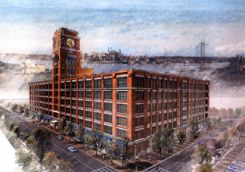
RCA building, Camden, NJ
| In 1938, Reinartz was called to active duty in the Navy as a personnel officer, assigned to assemble eligible, experienced, radio personnel for training and research. By Pearl Harbor, he had assembled a list of 720 reserve officers and 3,500 enlisted reserves who were quickly assigned to communications duties. |
|
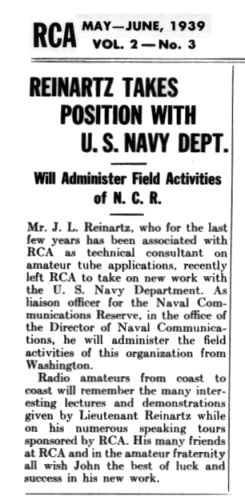 |
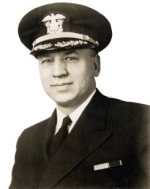
Reinartz served in the Navy until 1946, achieving the rank of captain.
|
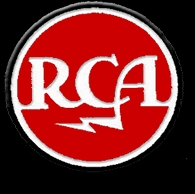
In 1946, he rejoined R.C.A. |
|
Reinartz and his wife came to California in 1949 and he joined Eimac as manager of the Amateur Service Department |
|
Reinartz retired January 30, 1960 from his post at Eimac. He and his wife, who now reside in Burlingame, plan to retire to Aptos, where they'll continue to be active on the air and Reinartz can get in plenty of fishing.
|
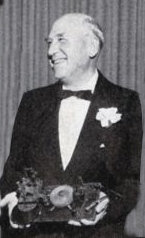 |
|
| |
|
Obituary
John’s health declined in 1964. On Sept. 18, 1964 Captain Reinartz received the first award of the “Hiram Percy Maxim medal” for the “greatest contribution to amateur radio in the last 50 years.” The presentation was made at his hospital bed at Fort Ord by Herbert Hoover Jr., President of the American Radio Relay League.
He was 70 when he died on October 5, 1964. |
|
|
| |
| |
|